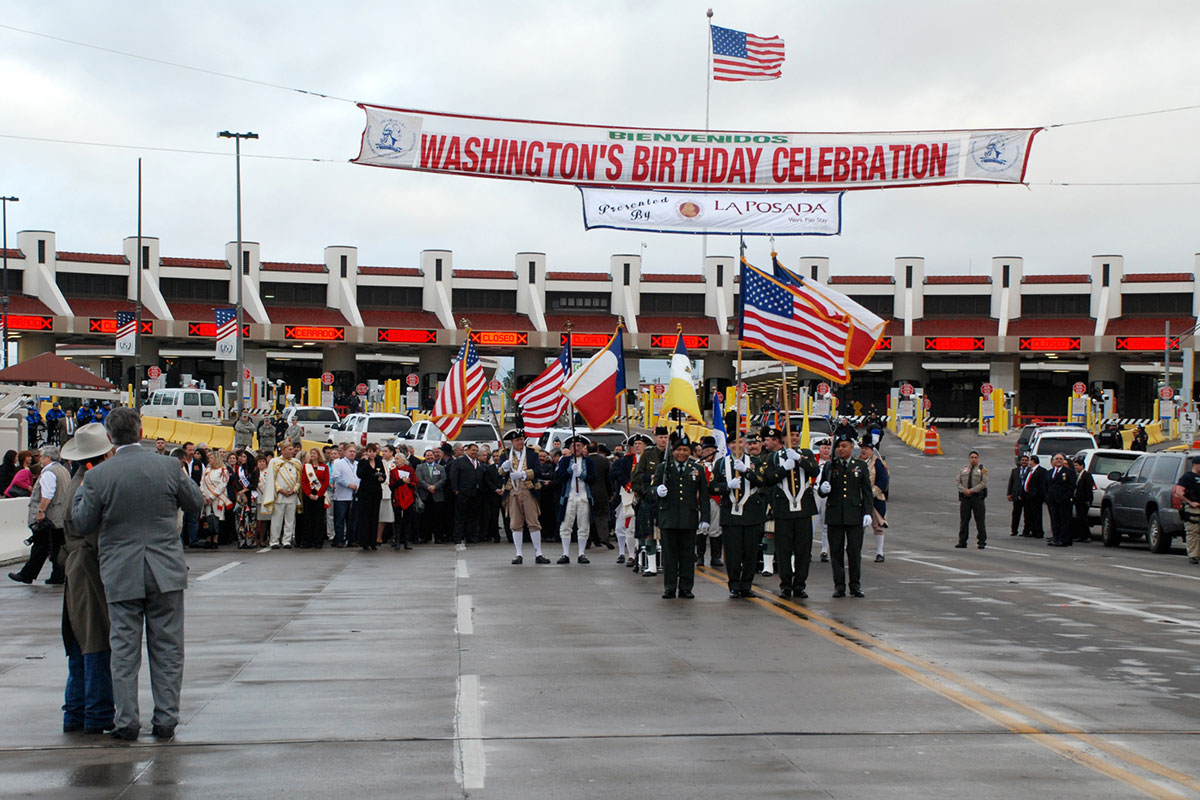February 1950. Laredo, Texas. My hometown.
In my first memory of watching the Washington’s Birthday Parade, I am sitting on my father’s shoulders, marveling at the horses, the dancing children, the soldiers and military tanks, and, most of all, the people swarming the streets.
We celebrate George Washington’s Birthday for a whole month in Laredo, the border town along the Rio Grande, the river our neighbors in Nuevo Laredo, Mexico, call the Río Bravo. When the Mexican-American War ended in 1848, Mexico lost more than half its territory, with the river as the boundary. That war divided our community as many of the families chose to relocate to the Mexican side of the border.
But in February, people from both sides come together to honor Washington’s legacy with the abrazo ceremony at the border, Air Force flight formations, an open house at Laredo Air Force Base (closed in the 1970s during Richard Nixon’s administration), and the ever-popular carnival. As a teenager, the latter was my favorite as it was where we would flirt with the guys from Mexico and enjoy the rides and the food. I would gorge on cotton candy and candied apples and feel the excitement of riding el Mazo or la Rueda de la fortuna, the Ferris wheel! We played games hoping to win the big giant teddy bear or some kind of knickknack. I happily enjoyed my community’s annual festival.

It was not until my twenties that I questioned why we went all out with weeks of preparation and celebration for someone as distant to our mejicano reality in Laredo as George Washington. The Washington’s Birthday Celebration Association claims this version of the event’s beginnings: “On the morning of February 22, 1898, Indians and white men engaged in a ‘battle’ for control of Laredo, Texas… In the end, the defenders fell and the mayor presented the key of the city to the Great Chief Sachem as a sign of unconditional surrender. The Great Chief in turn presented the key to the lovely Princess Pocahontas, who represented a lost tradition, ‘a vanishing race.’ The ensuring celebration among neighbors lasted for two days.”

But, of course, it’s a fake history. How could they present the key to Pocahontas, who died 281 years earlier? One historical record was clear: a few men—mostly white—had organized themselves into a local chapter of the Improved Order of Red Men, a fraternal organization supposedly established by the founding fathers. Like the others, the Laredo chapter—Yaqui Tribe #59—honored George Washington. They were the original planners of the event, celebrating the anniversary of the battle with a reenactment of the key presentation ceremony. Their invented pageant stages a history that never happened.
Why would they do that? A group of white men pretending to be Indigenous? Why would they “celebrate” the “red men” when at the same time they decimate and slaughter them? Well, in this context, it seems obvious to me. In Laredo, we were simply too Mexican, and the powers that be needed to speed up the process of our Americanization.
After all, we had been part of Mexico until 1848. By the 1920s, although some of the city business was still conducted in Spanish, the powers that be, mostly immigrants from the north who spoke English and ruled alongside the local Mexican/Tejano landowners, were grounding the Washington’s Birthday celebration even more zealously in one important message: Laredo was part of the United States.

As a folklorist who studies such events, I now appreciate that my hometown is only doing what other communities do: hold ostentatious displays of wealth and power with elaborate presentations that often include parades and balls. However, ours is unique in that it is transborder and involves both sister cities. Moreover, not all communities reenact an event that never happened!
So this year, as for the last 123 years, Laredo is decked out in red, white, and blue banners and once again hosting visitors from near and far. This weekend, the abrazo ceremony—officially the International Bridge Ceremony—will bring Mexican and American politicians and civic leaders together in an abrazo, a hug signifying our goodwill and tight bonds. The Stockman’s Ball sets off the festivities, and the Princess Pocahontas Pageant, the Jalapeño Festival, and many others have been added to the original fiesta. Children participate in the youth parade; teenagers will hang out with friends at the carnival; most young adults will laugh at the Jam for George comedy show; the daughters and sons of the elite will take part in the Colonial Ball, as they have for over a hundred years; the participants in the more inclusive Pocahontas Pageant will continue to enact a past that never happened.
But alongside those who will carry on this legacy, we find the many who are unable to afford the entrance fees or who are more concerned with earning a living than celebrating a historical past, a past as distant to their daily lives as the centers of power in Washington, D.C., or Mexico City. Their two countries nudge each other along a border that is, as Chicana scholar Gloria Anzaldúa reminded us, “an open wound where the third world grates against the first and bleeds.”
Norma Cantú is the Murchison Distinguished Professor of the Humanities at Trinity University in San Antonio, Texas, and a long-time collaborator with the Smithsonian Folklife Festival.
Resources
Las Marthas (Women Make Movies, 2013), Cristina Ibarra
¡Viva George! Celebrating George Washington’s Birthday on the US-Mexico Border (University of Texas Press, 2020), Elaine Peña




